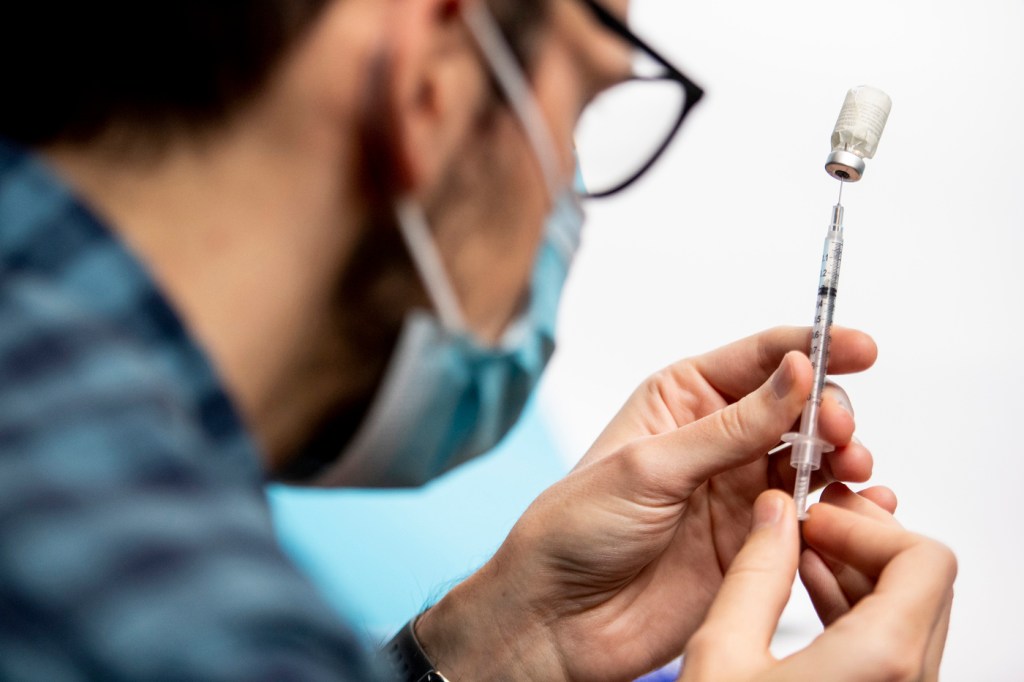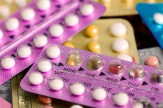Here’s how the Johnson and Johnson vaccine compares to others

At a time when ongoing logistical challenges and emerging new variants of the coronavirus continue to threaten the global push for mass immunization against COVID-19, a new vaccine from Johnson & Johnson could provide critical aid.
The vaccine, which is under review by the Food and Drug Administration for emergency use authorization, is more effective against new variants than other vaccines and doesn’t require special freezers for storage or shipment.

Mansoor Amiji, university distinguished professor of pharmaceutical sciences, left, and chemical engineering at Northeastern and Brandon Dionne, assistant clinical professor department of pharmacy and health sciences. Photos by Matthew Modoono/Northeastern University
At 66 percent effective at preventing COVID-19 overall, the Johnson & Johnson vaccine is less effective than the Moderna and Pfizer vaccines. But still, the pros of this new vaccine far outweigh the cons, says Mansoor Amiji, university distinguished professor of pharmaceutical sciences and chemical engineering at Northeastern.
“This is such a devastating disease. The need for vaccinations is incredible, and being able to offer another vaccine candidate and ramp up production really trumps any of the concerns about efficacy,” says Amiji.
Even at 66 percent overall efficacy, the Johnson & Johnson vaccine is considered a successful vaccine. The average flu vaccine usually hovers around 50 percent efficacy, Amiji says. Plus, 66 percent efficacy refers only to the overall results of the clinical trial. The Johnson & Johnson vaccine was 85 percent effective at preventing severe cases of COVID-19, and there were no deaths or hospitalizations among the group who received the vaccine in the clinical trials.
“This is the challenge when we talk about efficacy. What endpoint are you using? For Johnson & Johnson, their definition was: How many people are diagnosed with symptomatic COVID-19? So even though the vaccine didn’t prevent symptomatic cases quite as well as the Moderna or Pfizer vaccines, it did a great job preventing hospitalizations and deaths,” says Brandon Dionne, assistant clinical professor in the School of Pharmacy at Northeastern.
A one-dose regimen
Unlike the Moderna and Pfizer vaccines, which currently require a two-dose inoculation regimen, the Johnson & Johnson vaccine was designed to provide immunization in a single dose. The one-shot system is preferable, Amiji says, as patient follow-up for the second shot can be inconsistent, and supplies of the second dose are not necessarily guaranteed during the brief window of time when patients need to receive the second inoculation.
While a one-dose regimen is desirable, the company is also testing whether adding a second dose could increase efficacy. Rolling out a one-dose system now could start the immunization process while allowing the company time to determine whether a second dose would be beneficial, says Dionne.
Storage and shipping
The Johnson & Johnson vaccine can be stored at the temperature of a regular refrigerator for up to three months, making it more accessible to smaller doctor’s offices or neighborhood pharmacies that don’t have the ultracold freezers required to store other vaccines, such as Pfizer’s, at -94 Fahrenheit.
Additionally, the less temperature-sensitive vaccine makes transportation easier. Many shipping trucks and planes are already outfitted with the technology required to refrigerate the Johnson & Johnson vaccine, Amiji says.
“These vaccines have to reach large masses around the world,” says Amiji. “When we look at early distribution of vaccines, most of the effort has been to vaccinate the developed nations, but for this pandemic to come to a close, we have to think about going beyond those borders.” Fewer obstacles in shipping and storage could help the vaccine reach more remote areas.
Protection against new variants
New variants of the virus, which have cropped up in the United Kingdom, South Africa, and Brazil, have created concern about whether the vaccines currently in distribution will continue to protect patients from new strains. The variants from South Africa and Brazil, called B.1.351 and P.1 respectively, present the biggest challenges because of mutations that affect the same part of the virus—the spike protein—that the vaccines imitate to create immunity.
The South African government recently suspended its plan to distribute the AstraZeneca vaccine after a study—though limited and not yet peer-reviewed—found the vaccine provided only “minimal protection” against B.1.351.
Clinical trial data for the Johnson & Johnson vaccine, which were collected in multiple countries while new variants were already in circulation, showed the vaccine was 66 percent effective in South America, and 57 percent effective in South Africa.
Lab results for the Moderna and Pfizer vaccines, which underwent clinical trials before these new variants emerged, show that both vaccines provide comparable protection against the U.K. variant, called B.1.1.7, but diminished efficacy against B.1.351 and P.1.
But even with these results, researchers don’t know for certain how the Moderna or Pfizer vaccine interacts with the new variants. “You can’t fully mimic the immune system in a lab,” says Dionne. “Even though there seems to be reduced efficacy in the lab, we don’t really know how that plays out in the human body.”
As a precaution, the companies are testing whether booster shots could increase protection against new variants.
For media inquiries, please contact media@northeastern.edu.





